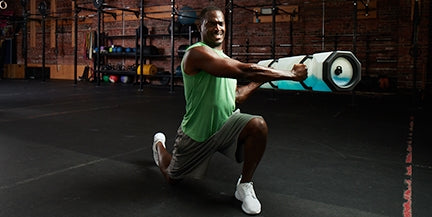No Gains? Here’s Why!

How do top athletes and fitness enthusiasts maintain gains and results-oriented progression? The magic lies in understanding the science, the how and why of recovery strategies, and accessory training.
First, don’t violate the principle of periodization, which is simply defined as cycling intensity and volume of training, along with exercise variation, over specific time periods. In other words, you lose if you train the same all of the time, or you mix it up every workout. Optimal adaptation occurs with the right amount of consistency, and knowing when and how to change-it-up before you break physically or mentally.
Secondly, just in case you’re thinking I am going to suggest some juicy rest days, think again. This is where complementary or accessory exercises come in to play. Be clear! This type of training is not necessarily easy training. Accessory training is focused, efficient and DIFFERENT. “Different” is good. Using the right kind of accessory exercises and training tools can help you improve training results, avoid plateaus, minimize overuse injuries and rev up your gains.
Many coaches and fitness professionals are turning to Hydro-Training to accomplish effective accessory training. If you don’t know what Hydro-Training involves, it’s time to dig-in. Hydro-Inertia® uses the reactive properties of water as the foundation for creating an unstable resistance training tool. Improved stabilization and body control are important outcomes when using water-reactivity to challenge the body with unique and ever-changing stabilization and force production challenges. Hydro-Inertia® requires the musculature and fascia of the body to turn on/off like it does in real life and sport.
Unstable resistance exercises with the SURGE® Storm require greater core involvement and muscle activation, which translates to improved total body stabilization. Instability resistance training exercises can also provide training adaptations for coordination and other motor control issues, which has performance implications for any level athlete. Accessory training and instability resistance training result in a win-win whether you simply want to get fit, perform better in your sport, avoid injury or lift heavier weights.
An important aspect of accessory training is to lift, or train, with submaximal loads to 1) off-load the body for recovery from heavy lifting protocols, and to 2) simultaneously increase total body stability, body control, and to 3) practice similar movement patterns under lighter loading that transfer well to traditional lifts or sport movements. In other words, if you can improve your balance and stability -- then strength and power can increase (see references).
Each of the following exercises requires total body stability and body control. Now, let’s add water!
SURGE® Jump Plank to Clean & Jerk
Hold the SURGE® Storm in a neutral grip in front. Squat and lower it to the floor, then jump back to a plank and quickly jump back to squat. Pull from the floor to a clean position in front of the chest. Jump to a lunge stance and simultaneously press overhead. Hold, then step back to the starting position. Repeat, alternating sides on the lunge stance each rep.
SURGE® Shoulder Carry Lunge & Press
Hold the SURGE® Storm in a wide grip in front. Step forward into a lunge while simultaneously swinging it into a shoulder carry position. Perform 3 lunge jumps, switching sides each rep, then lower the SURGE® Storm to the front. Step back to a hip width stance, lifting the SURGE® Storm overhead, then lower it back to starting position. Repeat, alternating sides on the lunge / shoulder carry each rep.
SURGE® Rotary Punch & Dump
Hold the SURGE® Storm in a neutral grip in front. Pivot and punch to one side 3x, then pause in the pivoted position. Extend the arms and turn the SURGE® Storm vertical, letting the water dump to the bottom. Repeat twice more, then pivot back to the front and repeat the sequence on the other side.
Get Your Gains On
Accessory exercises can be programmed in pre workout, post workout, within a workout, or a more aggressive approach may include an entire workout focused on complementary exercises to drive metabolic response or to improve muscular endurance and strength, balance, mobility, core strength, stabilizing capability, and power.
Douglas Brooks, M.S., Exercise Physiologist, is Director of Programming for SURGE® and specializes in sport conditioning and strength training
Learn, train and engage with other fitness professionals at SURGE® Live Education courses. For information on our cutting edge content, taught by the best in the industry, click HERE.
References
Beardsley, Chris, Why are strength gains stability-specific? (Strength is specific.)
Study link: https://www.strengthandconditioningresearch.com/perspectives/free-weights-unstable-surfaces/
Behm, David and Juan Carlos Colado (2012), The Effectiveness of Resistance Training Using Unstable Surfaces and Devices for Rehabilitation, International Journal of Sports Physical Therapy.
Study link: https://www.ncbi.nlm.nih.gov/pmc/articles/PMC3325639/
Behm, David and Juan Carlos Colado (2012), The Effectiveness of Resistance Training Using Unstable Surfaces and Devices for Rehabilitation, International Journal of Sports Physical Therapy.
Study link: https://www.ncbi.nlm.nih.gov/pmc/articles/PMC3325639/
Glass, SC, and Albert, RW. (2018) Compensatory muscle activation during unstable overhead squat using a water-filled training tube. Journal Strength Cond Res 32(5): 1230–1237.
Glass, SC, Blanchette, TW, Karwan, LA, Pearson, SS, O’Neil, AP, and Karlik, DA. (2016) Core muscle activation during unstable bicep curl using a water-filled instability training tube. Journal Strength Cond Res 30(11): 3212–3219
Mate’-Munoz, JL et al (2014). Effects of instability versus traditional resistance training on strength, power and velocity in untrained men. Journal of Sports Science Medicine, September, 1-13(3): 460-8



